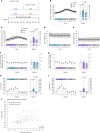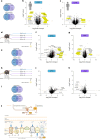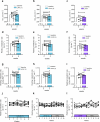Dietary protein restriction elevates FGF21 levels and energy requirements to maintain body weight in lean men
- PMID: 40050437
- PMCID: PMC11946896
- DOI: 10.1038/s42255-025-01236-7
Dietary protein restriction elevates FGF21 levels and energy requirements to maintain body weight in lean men
Abstract
Dietary protein restriction increases energy expenditure and enhances insulin sensitivity in mice. However, the effects of a eucaloric protein-restricted diet in healthy humans remain unexplored. Here, we show in lean, healthy men that a protein-restricted diet meeting the minimum protein requirements for 5 weeks necessitates an increase in energy intake to uphold body weight, regardless of whether proteins are replaced with fats or carbohydrates. Upon reverting to the customary higher protein intake in the following 5 weeks, energy requirements return to baseline levels, thus preventing weight gain. We also show that fasting plasma FGF21 levels increase during protein restriction. Proteomic analysis of human white adipose tissue and in FGF21-knockout mice reveal alterations in key components of the electron transport chain within white adipose tissue mitochondria. Notably, in male mice, these changes appear to be dependent on FGF21. In conclusion, we demonstrate that maintaining body weight during dietary protein restriction in healthy, lean men requires a higher energy intake, partially driven by FGF21-mediated mitochondrial adaptations in adipose tissue.
© 2025. The Author(s).
Conflict of interest statement
Competing interests: The authors declare no competing interests.
Figures










References
-
- Keller, U. Dietary proteins in obesity and in diabetes. Int. J. Vitam. Nutr. Res.81, 125–133 (2011). - PubMed
-
- Wycherley, T. P., Moran, L. J., Clifton, P. M., Noakes, M. & Brinkworth, G. D. Effects of energy-restricted high-protein, low-fat compared with standard-protein, low-fat diets: a meta-analysis of randomized controlled trials. Am. J. Clin. Nutr.96, 1281–1298 (2012). - PubMed
-
- Magkos, F. The role of dietary protein in obesity. Rev. Endocr. Metab. Disord.21, 329–340 (2020). - PubMed
MeSH terms
Substances
Grants and funding
- NNF17OC0029054/Novo Nordisk Fonden (Novo Nordisk Foundation)
- NNF18CC0034900/Novo Nordisk Fonden (Novo Nordisk Foundation)
- NNF23SA0084103/Novo Nordisk Fonden (Novo Nordisk Foundation)
- NNFOC0074110/Novo Nordisk Fonden (Novo Nordisk Foundation)
- Lily Award/European Foundation for the Study of Diabetes (EFSD)
LinkOut - more resources
Full Text Sources
Medical
Molecular Biology Databases

